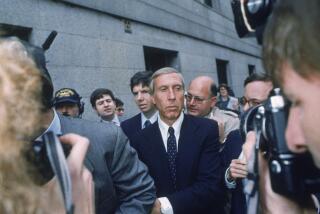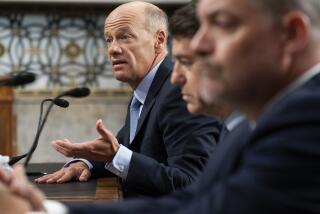SEC Chief, GAO Aide Disagree on Amount of Insider Trading
- Share via
WASHINGTON — Securities and Exchange Commission Chairman John S. R. Shad said today that insider trading makes up only a small amount of daily stock transactions, but another federal official said the problem could be larger.
“We have no idea if we are getting to 10%, 1% or a tenth of 1% of the problem,” William J. Anderson, assistant comptroller general of the General Accounting Office, told a House Investigations and Oversight subcommittee.
Anderson said there is insufficient data to determine how much insider trading is going on and how effective the SEC and the stock exchanges are in catching violations.
Shad defined insider trading as using important non-public information to make a profit. He said much of what is commonly thought to be insider trading is legal speculation based on rumors and gossip.
The GAO, the investigating agency of Congress, was asked to review enforcement of insider trading laws after speculator Ivan F. Boesky agreed to pay $100 million in penalties last month to settle a case brought by the commission.
“There is too much insider trading, but it should not be exaggerated out of proportion. Such cases amount to less than 10% of the commission’s annual enforcement actions,” Shad said in his testimony.
“There is no reason to believe that fraudulent securities activities amount to more than a small fraction of (the $50 billion in daily securities) transactions, and insider trading is but one of many fraudulent securities activities,” he said.
Shad said the recent actions against Boesky and former Drexel Burnham Lambert Inc. merger specialist Dennis Levine should send a strong warning to other investors against insider trading.
“These cases show that inside traders, even those who are large and successful market professionals, can no longer escape detection or prosecution for their illegal acts,” he said.
Better Methods Needed
Anderson said that the SEC and the stock exchanges have developed sophisticated computer surveillance systems to detect questionable trading but that other and better methods are needed.
“These systems can provide an important and necessary part of the story. But they do not produce irrefutable evidence showing who passed inside information to whom,” he said.
Subcommittee Chairman John D. Dingell (D-Mich.) said it was an anonymous tip that started the investigation against Levine that eventually led to Boesky, despite all the computer programs to defect suspicious trading.
More to Read
Inside the business of entertainment
The Wide Shot brings you news, analysis and insights on everything from streaming wars to production — and what it all means for the future.
You may occasionally receive promotional content from the Los Angeles Times.










